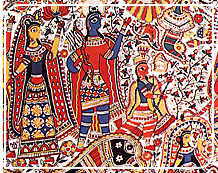Shopper's Paradise: Paintings
 Rock painting in caves are the earliest specimens we have of folk-art, as
conventionally understood.
Rock painting in caves are the earliest specimens we have of folk-art, as
conventionally understood.
FLOOR PAINTING
When we
come to a later period, we find a definite established tradition of
paintings on various objects, particularly floors, walls and on intimate
objects of everday use, and in most instances the act being associated
with some ritual. The origin of painting is traced to a moving legend
recorded in the Chitralakshana- the earliest Indian treatise
on painting. When the son of a king's high priest died, Lord Brahma (the
Creator) asked the king to paint a likeness of the boy so that he can
breathe life into him again. This is how the first painting was made.
The Chola rulers in the south, made extensive use of kolam,
floor designs. These decorations done only by women are amongst the most
expressive of folk-arts. They are known by different names in different
parts of the country, alpana in Bengal and Assam,
aripana in Bihar, mandana in Rajasthan,
rangoli in Gujarat and Maharashtra, chowkpurana
in Uttar Pradesh (except the Kumaon refion) and kolam
in the South.
The Rajasthan mandana is equally
rich. Floor paintings in Andhra are known as muggulu and
Himachal Pradesh has it own distinctive floor paintings with geometrical
patterns.
WALL PAINTINGS
The paintings on walls
have deeper themes, also narratives in a series of panels. Apart from
their decorative purpose, they also constitute a form of visual education
like picture books from which one learns of one's heritage.
Wall
paintings in Punjab, outer Delhi and Rajasthan are
usually made at festivals and special occasions like marriages.
Folk paintings in Rajasthan attained a high standard and artists
won great fame in this art. The themes are from epics and heroic Rajput
tales. In the Kumaon, the usual wall pictures are known as bar-boond
(dash and lot). The pattern is done by first putting down a number of dots
to make the ouline of the design, then joining them together by lines in
different colours. This calls for intense concentration and immense
patience, for an error in a single dot or dash can upset the entire
composition. Each pattern is known by the number of dots used. One is
known as masti-bar-mat design, a composition of ten dots and
the colours used are yellow, violet and green. There are all-over designs
of roses and jasmines covering the entire wall.
PHAD
PAINTINGS
Phad paintings are predominantly yellow, red and green
coloured long scrolls carried by the 'Bhopas' itinerant balladers of Rajasthan,
who narrated in song the legend of Punjabi - a local hero - on auspicious
occasions to the accompaniment of the folk instrunemt 'Ravanhatta'
made by the Joshis of Shahpur, near Bhilwara. Phads are now also available
in smaller panels portraying single incidents or characters from the epic.
MUGHAL MINIATURE PAINTINGS
Of all the art forms in
the Mughal period, miniature paintings are painstakingly painted creations
that depict the events and lifestyle of the Mughals in their magnificent
palaces. Other paintings include portraits or studies of wildlife and
plants. This art is still alive and popular in Rajasthan and Uttar
Pradesh.
MUDHUBANI
The wall paintings of Madhubani
are joyous expressions of the women of Madhubani, Bihar.
The lively compositions and the vibrant colours to paint them are
generally drawn from Indian mythology.
IDEAL PLACES TO SHOP
Bihar, Rajasthan, Uttar Pradesh, Gurajat, Maharashtra, Madhya Pradesh,
Bengal.
Rock painting in caves are the earliest specimens we have of folk-art, as conventionally understood.